
Abandon Ship! Prepare to Die!: How the U.S. Navy lives in Denial and is not ready for combat
By Mike Sparks, Director, 3rd Tactical Studies Group (Maritime)

"Abandon ship!" The calls goes throughout the doomed ship and Sailors and marines enter lifeboats that eject out and they then wait in the water fully protected awaiting rescue.
The problem is this is a Hollywood science fiction movie not reality. The reality is like the Russian submarine Kursk, Sailors in the U.S. Navy walk around fuel-laden and bomb loaded ships in civilian clothes just like you are probably wearing behind your computer screen reading this white paper. When the time comes to abandon ship, U.S. Navy Sailors/marines jump into the water and end up dying of exposure or eaten by sharks. The inflatable life rafts are in barrels that pop open and the raft unfolds itself into the water. Whether you can get to the raft before burning to death from flaming aviation or ship fuel, drowning or exposure is not guaranteed. Escape pods are only on TV and the movies. If you do make it to a raft be prepared to wait on an average of 8 days for rescue; you will die from a lack of water as the sun beats merciless upon you. Rescue? How?
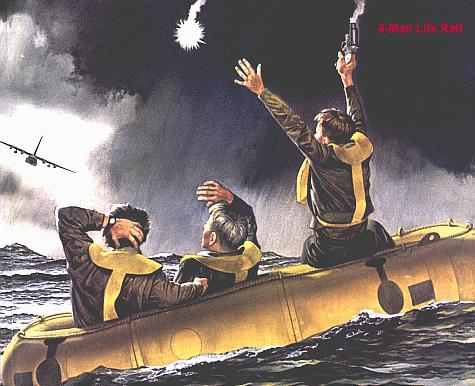
The Navy no longer operates seaplanes that can land and pick dozens, even hundreds of men up from the water like it did in WW2. Fixed-wing planes can drop things to you. We gave up on Fulton STAR ("SkyHook") so they are not going to be able to pick you up.
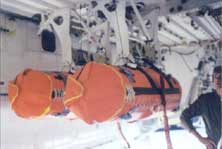
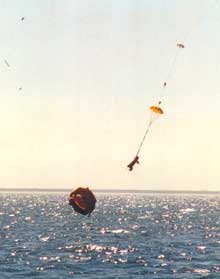
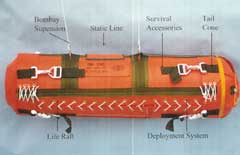
Only a few short-range helicopters operated from ships that themselves are in jeopardy by enemy sinking and not likely to venture into harm's way to pick up survivors in the water. Since WW2, lacking an enemy that has attacked the U.S. Navy in full-fledged blue-water naval combat, the Navy has forgotten what "right looks like" and is living in denial that its ships will get sunk and that it needs to improve crew escape to the correct standard that even Hollywood writers realize is necessary.
Making the Navy's denials even more absurd and dangerous is that without an on-going nation-state enemy navy to fight daily (Red China should be a top priority) they are embracing a brown-water littoral combat strategy that will place unimproved large ocean-going ships close to shore batteries of guided missiles, sea mines, attack aircraft, undetectable diesel-electric submarines with guided torpedoes begging for a ship to be sunk with the loss of all hands. Its hard to figure if the Navy has a death wish or is simply so arrogant that it thinks its ships are unsinkable?
Now apologists for the Navy will say, we should put every waking ounce of energy we have into making ships not get sunk in the first place. OK, then bring back the Iowa class battleships, heavily armor the ships we have, reduce crews by automation, replace P-3C Orions with jet seaplane patrol bombers, get ASW blimps, arm every surface ship with a F-35 JSF on top of an ASW helicopter, convert container ships into amphibious assault carriers, containerize the Army/marines so we can unload them to shore quickly, start developing submarine aircraft carriers and assault landing ships, we can go on for days about how the Navy needs to improve so it doesn't get itself sunk in the brown and blue waters of planet earth. The Coast Guard who has rescue expertise and equipment needs to be merged into the USN to embed rescue capabilities. Read our web page here:
falklandslessonsnotlearned.htm
However, the world of oil well platforms knows what the USN doesn't--that when doing violent acts like piercing the earth for fossil fuel that things go wrong and men are thrown suddenly into the water where they drown and die of water temperature hypothermia exposure. What they do is they have immersion suits and actual TEMPS-C escape pods--fully enclosed lifeboats that you enter and they shoot into the water--just like it should be as seen in the movies. Its high time the U.S. Navy develop a similar escape pod and minimalist individual escape capability on all its ships.
Naval Combat Uniform (NCU)
First off, this bullsh*t of people wearing civilian clothing that will go up in flames in event of a fire and explosion on a ship must stop immediately. Next, this bullsh*t of those with rank wearing different more "sexy" looking uniforms than those of lesser rank must cease. Its time to respect the forces of the earth itself--the sea and to start living for combat through teamwork not snobbery and elitism. Whatever happened with "we are all in the same boat together" as not just an American proverb but an actual cultural value? American Sailors are not all in the same boat together--officers live in a different part of the ship where the air conditioning works in the snobby surface navy. This must stop at once. Every day, Sailors should dress for NAVAL COMBAT starting with a fire-resistant Nomex CWU-23 flight suit in Navy Blue camouflage that would blend in with dark blue water so the enemy cannot easily identify and pick you off in the water with gunfire. This happens in war and its time we stop denying it. If a USN ship is hit and explodes, if you are not already wearing the Nomex you are going to burn up and die right there.
Over the top of the Nomex would be a Navy Body Armor (NBA) for ballistic protection based on the successful U.S. Army IBA but reversible--one side is blaze orange for rescue and the other Navy blue for combat camouflage. The NBA should float.
Critical to defeating pirates/terrorists on the high seas, we need an explosive shell autocannon that can be mounted on very small boats; bullet-shooting machine guns lack the lethality to intimidate and destroy these enemies. Notice in the vdeo clip above that even the civilian gunner has dressed up correctly to play the part of a deck gunner with kevlar helmet, flak jacket and floatation vest over the top.
On the head would be a Navy Combat Helmet (NCH) derived from the MICH/ACH helmet but with electrical intercom headset connector kits for Navy ship duty. A smoke hood should be built into the helmet so all you have to do is pull down and stretch it over your face and neck to get an airtight seal. It may even be possible to have an air-breathing snorkel with water purge fitted so if a Sailor is thrown into the water amidst crashing waves he can still breath and not drown. Currently, the ballistic helmet has to be taken off before jumping into the water because its open bottom will trap the water and break your neck upon impact. With the smoke/water hood the head and helmet would be streamlined for water entry. It may be possible to integrate a sun-activated reverse osmosis water desalinator into the hood so drinking water could be obtained to keep the Sailor alive for even several days until he is rescued.
I'm not sure whether footwear should have a heel or not for going up/down ladders on USN ships. Certainly for maximum ankle protection, the leather or Kevlar boot is best. This may freak the reader out, but I propose that the Navy Combat Boot (NCB) have a lever to extend swim fins from the boot's sole when in the water. As a weak swimmer, I have discovered that with swim fins I am "aqua-man". Why must we go around brow-beating those who cannot swim well and exalting those that do? Is the Navy a giant ego trip or are we pulling together for each other? Before giving the standard pull-yourself-up-by-your-own-boot straps reply of self-punishment to "go to the pool and improve your swimming abilities" lets face the FACTS that you may be thrown into the water AND NOT BE ABLE BODIED. We all admire LT John F. Kennedy and how he swam and saved his crew in WW2, but he was not wounded. When he was done, he was exhausted. What if you only have one working leg and no JFK strong swimmer to tow you to safety? You drown, of course. If every Sailor had NCBs with pop-out fins, if they were wounded their swimming efficiency would be improved so they could propel themselves in the water, and if they were able bodied they could save more men with less energy. YES, the swim fins popping out of the NCB would LOOK imaginative, creative, scien-fiction-ish and "too high speed" for the narrow-minded egomaniacs populating our military. Many will even laugh and call them "stupid" because it doesn't fit into their narcissistic fashion trip. If it its "stupid" and it works, its not "stupid". The inflatable life preserver was mocked as the "Mae West" (actress of that era with big breasts) in WW2, but it saved thousands of lives. Maybe the macho mocking of anything innovative is a systemic cultural corruption of the weak egomaniacs that flock to U.S. military service? You would think people who are technological and not against equipment advantages would inhabit our military but sadly they are a very small minority to those who want decent wages and a chance to go order those around with lesser rank like mini-tyrants. Life and death are serious issues and there is no consolation prize for losing. You die, nothing follows in this life. Its high time we start doing EVERYTHING we can to save lives and stop limiting ourselves because it bothers our male macho ego. The NCB will look like any other military boot until a lever is thrown and the fins pop out.
I have looked at immersion suits and they have the drawback of TIME---you must have time to put them on and in a military ship exploding and throwing you in the water you don't have it. Even if you did your survival time in the water is about a day in the North Atlantic.

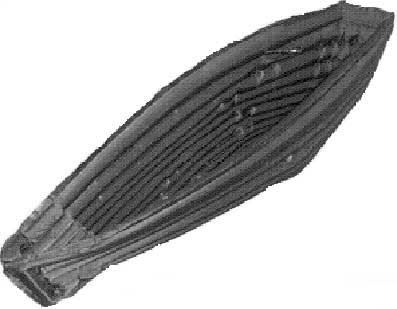
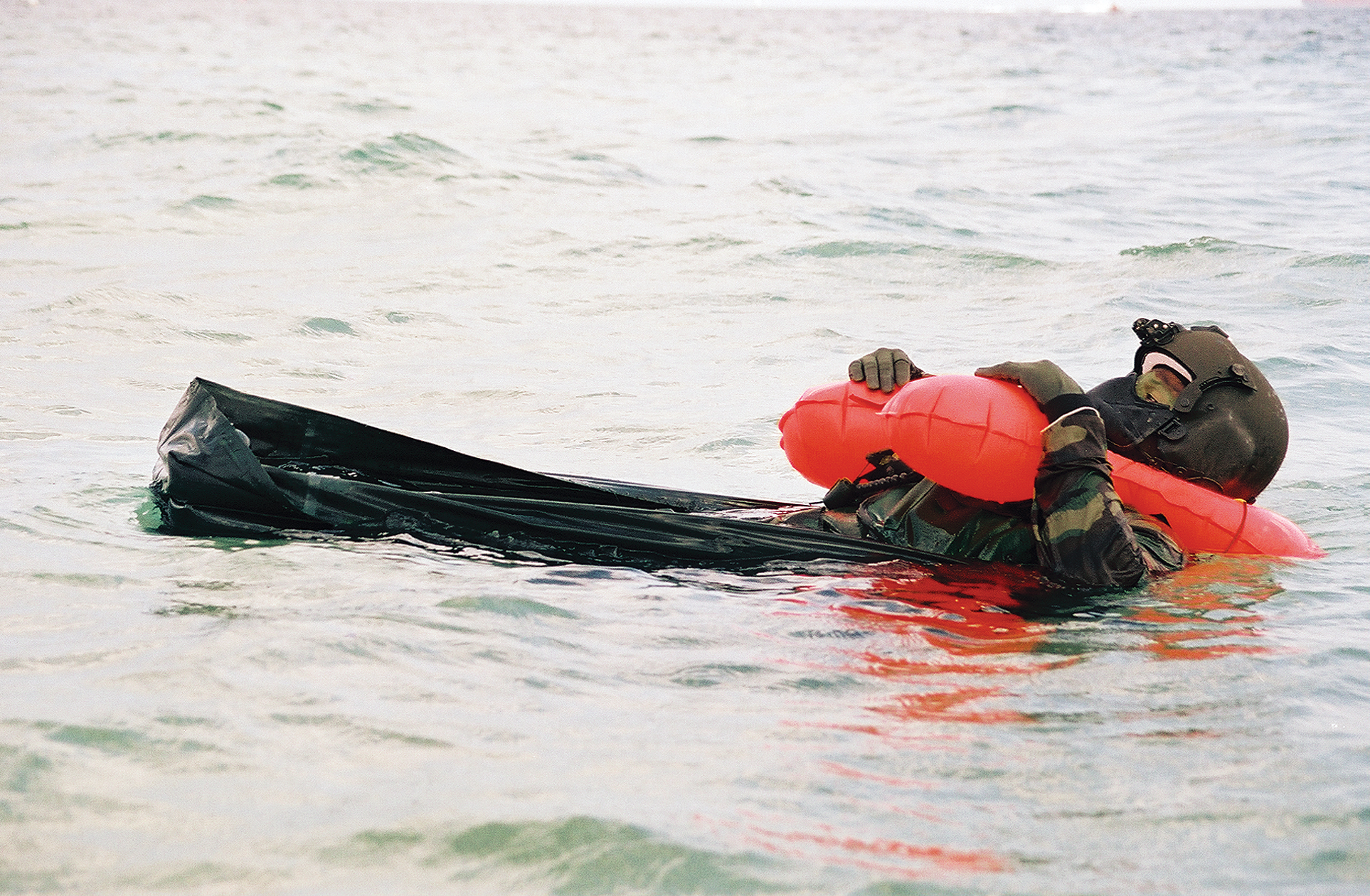
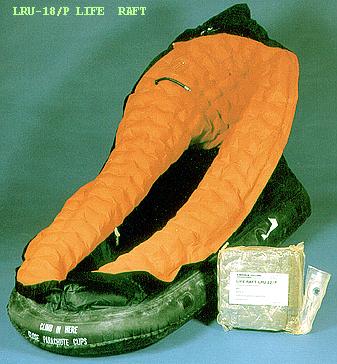
The answer we believe is to have every Sailor wear a small LRU-18 pilot's inflatable lifeboat instead of a chest life preserver since the naval body armor floats and fulfils that task of immediately keeping the man head above water. THERE IS NO GUARANTEE THAT THERE WILL BE ENOUGH OR EVEN ANY LIFEBOATS after a ship sinks or a plane crashes. Once he is safely away from the sinking/burning ship/plane, the Sailor can inflate the LRU-18 and then get himself OUT OF THE WATER to prevent dying from exposure. Is it less than ideal compared to being dry from the beginning in an immersion suit? Yes. But its "good enough" and its a synergism that can be worn during combat duty stations 24/7/365 anywhere on the ship.
In one of the pockets of the NCU, probably on a shoulder would be an IR stroke light and a GPS locator/transmitter that would be battery powered but have a small hand crank to recharge the battery and keep the strobe/transmitter going indefinitely. Also in another pocket should be a shark repellent compound, and on the boot leg a small survival knife with hollow handle for SERE items like magnesium flint for fire starting etc. in case the Sailor washes onto shore and has to survive on land.
In summary, the NCU essentially turns every Sailor into a fighter pilot who incidentally could be thrown into the water after an ejection or bail out. Why is the lives of our Sailors any different? The earth doesn't give a crap about the social standing of the human thrown into the water. Dead is dead. So why shouldn't a Navy combat Sailor dress any different than a fighter pilot when he shares the same risks of being thrown into the water? So what he will look "sexy" in a flight suit. That's too fucking bad. Its time we start giving a damn about ourselves and our men and start doing what's FUNCTIONALLY RIGHT to save their lives and drop the fashion statement crap.
Other Combat Gear
Former Navy "BlueJacket" Steve Cook writes:
"I like it. The pop-out swim fins is an intriguing idea. I would add a dye marker packet, too, just in case the IR strobe/GPS systems fail. Leave the service and dress uniforms at home, there's no need for that fancy stuff at sea. Wear that stuff ashore. The personal life raft is a good idea, too. Everybody wears the same uniform, regardless of rank. That's a good policy, and I believe that will help improve morale and foster team spirit which leads to increased teamwork.
I would probably issue some combat gear--web utility belt with knife and scabbard, ammunition pouches for pistol and rifle magazines, first aid kit, canteen, emergency food rations, flashlight, matches in a waterproof container, pistol holster, etc. This stuff can be worn as needed.
You're on the right track, Mike."
Naval Combat Escape System
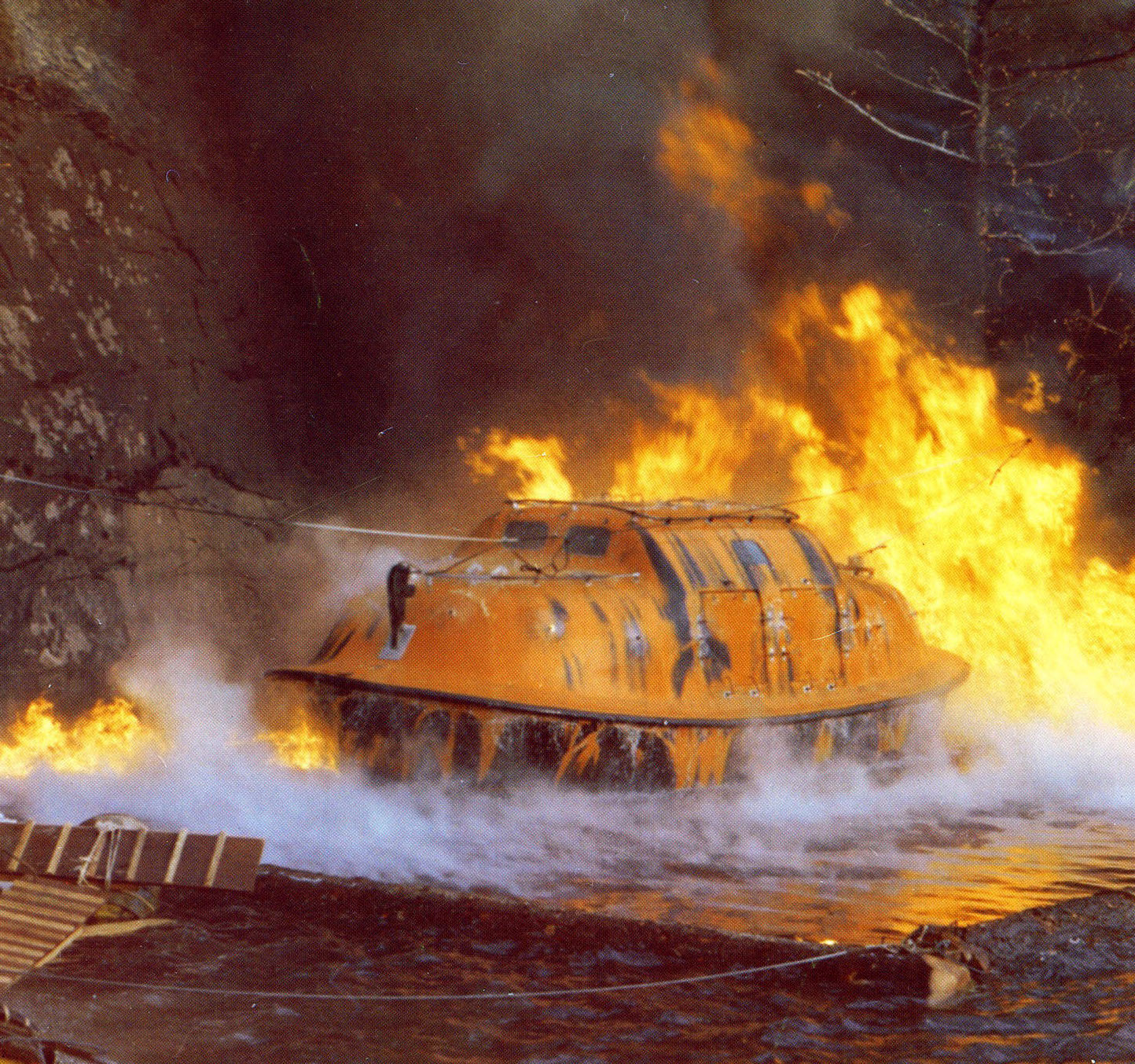
Every ship should have TEMPS-C type covered lifeboat escape pods that all Sailors have to do is get inside and launch into the water. Future ship designs must from the get-go have escape pods to include submarines so we do not have a Kursk type tragedy.
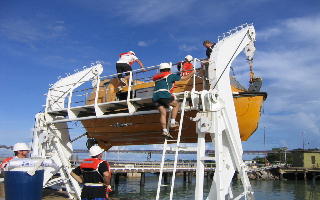
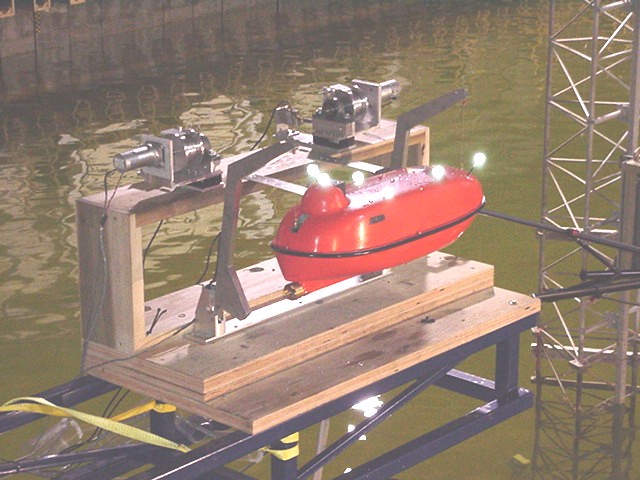

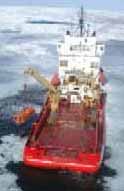
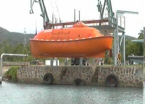
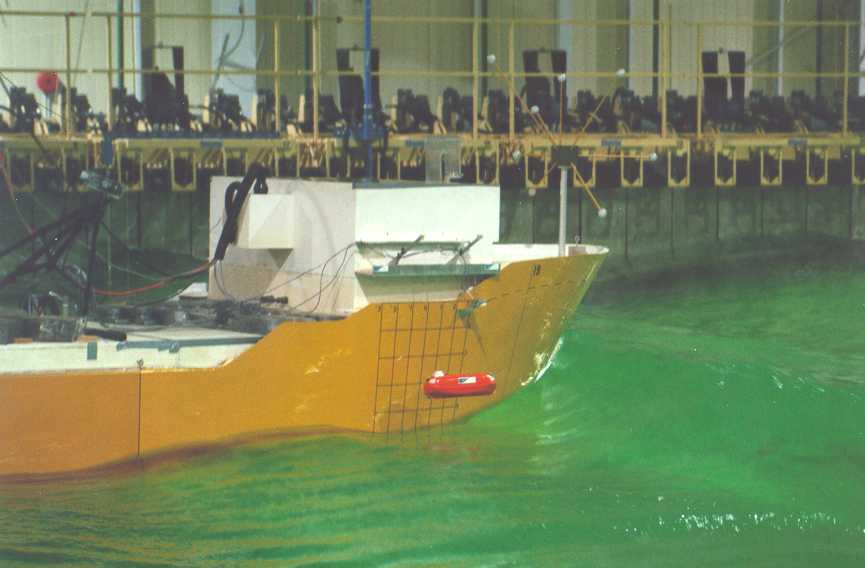
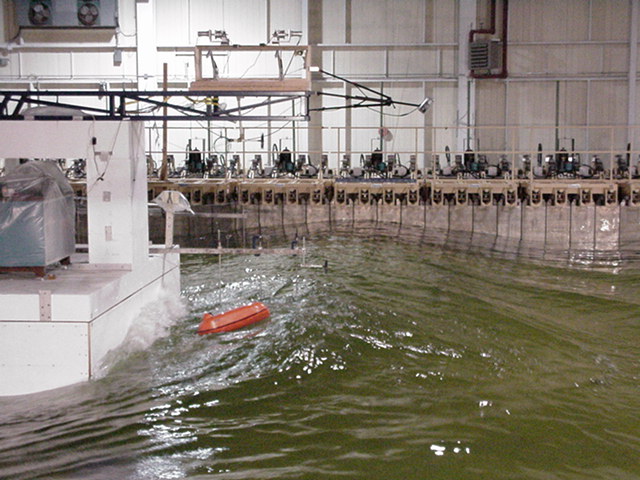
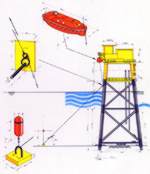
Not having an escape pod that is instant is a criminal offense not unlike NASA not having ejection seats at least for the boost phase into orbit that could have saved the Challenger astronauts who were ALIVE as they tumbled in a fragment after the solid rocket booster explosion. We should start by taking a DDG-51 and retrofitting TEMPS-C type lifeboats to determine how best to add this technology.
Crisis in the U.S. Navy

Drinking Water while in peril in the sea

We know from the tragedy of the USS Indianapolis that hundreds of men could be suddenly thrown into the water with just what's on their body. Many of the 900 died because of a lack of water.

At WW2's end the Navy finally fielded solar stills but these are not ON EVERY SAILOR they are in life rafts that the Sailor may not even have the luxury of reaching.

We have new reverse osmosis pump desalinators and these should be integral to the LPU-18 life vest/raft EVERY SAILOR has on him at ALL TIMES when he's on a ship. Able to create his own drinking water, a Sailor in the ocean could last for many days without food to survive long enough 'til rescued. The average wait in WW2 when we were on the ball with a balanced Navy that actually had seaplanes was 8 DAYS.
ROWPUs appear to be in widespread use in USN and USAF. I haven't found how many liters/gallons they can make before being exhausted.
www.armada.ch/02-1/digest.htm
Survivors Can Be Very Small
Survival at sea depends upon quite a few conditions - the most important being the availability of potable water. Katadyn remedies this situation with its Survivor 06 and 035 survival-proven desalinators. Replacing the US Navy's age-old solar stills and desalination tablets, the Survivor series use reverse osmosis: squeezing the salt water through a semi-permeable membrane fine enough to remove salt and other contaminants. The MROD-06-LL (photo) is an extremely small hand-operated desalinator, providing one litre of fresh drinking water, from seawater, per hour. It's larger brother, the MROD-35-LL - or 035, is a 3.2 kg hand-operated pump that produces over four litres per hour.
...and, on Ebay, of all places, good info: http://cgi.ebay.com/ebaymotors/PUR-KATADYN-SURVIVOR-MROD-06-LL-1-MANUAL-DESALINATOR_W0QQitemZ200014432634QQcmdZViewItem
...and, on the Internet, this good page:
www.bwsailing.com/01articles/issue/0803/special%20section.htm
LIFE on a RAFT
When you find yourself in a life raft, after the proverbial step up from the sinking deck of your boat, you are, from that point on, dependent on a long and complicated search-and-rescue apparatus, which is vastly improved and made more efficient by your having a properly registered and functioning EPIRB or GPIRB.
If you are in the North Atlantic, you probably won't be in your life raft for very long, several days at the most, until you are found and rescued. Even if you are confident of quick rescue, your first day on the raft should be organized as though it was the first of many. If you don't have an EPIRB, you will almost certainly be in the raft for a while, and you will need water very soon, followed by food.
You will have water with you, at a minimum you will have the water that is packed with the life raft, packed in small, flexible pouches. In years past, life rafts came with water in cans, lacquered and sealed to keep rust at bay. You may have managed to bring some jugs from the boat, if you had the time, but no matter how much you have, it is a finite supply and will eventually run out. This isn't about water rationing, though, it's about water making.
We recently had an opportunity to thoroughly test four hand-operated watermakers, all made by Katadyn, and it has changed our perception of life raft survival. We first tested a 13-year-old Survivor 06, made by Recovery Engineering (now part of Katadyn North America). Katadyn recommends testing their watermakers annually, and if it meets the design specification, you "pickle" it and put it back in storage.
This particular watermaker had been purchased in 1990 and put aboard the boat a BWS staffer was taking around the world. They came back, the watermaker was never used, and it sat in a box full of gear removed from the boat, unserviced, untouched, for eight more years. At 13 years of age, we took it out and tested it against two new 06 models from Katadyn, the standard 06 civilian model and the military model, the MROD-06-LL (as the military calls it), and the Survivor 35, a larger (much) version of Katadyn's manual watermaker.
We were very interested in the performance of the 13-year-old 06. There was some slight staining in the saltwater hoses, but it otherwise looked as good as new. It is identical in nearly every respect to the newer model, and we dropped the paired saltwater hoses into Narragansett Bay. After some 30 strokes of the handle, water began to come out, and then we pumped an additional 80 strokes to clear the pump's membranes, the recommended procedure when first using it. We gave a tentative taste to the water, and it was sweet and good, very much to our surprise.
"You may see some reduction in the output," said Alan Lizza, director of Katadyn North America, "probably because the membranes have dried out. We've never tested one this old, so we would be interested in the performance."
We were suitably impressed. It put out water that was perfectly good, as good as any water you would buy in a bottle, but indeed the output was less. We gave it 100 strokes, and the veteran put out less than an ounce of water. We pumped as fast as we could, taking two minutes and 30 seconds. Pumping slowly, taking just over three minutes, the output was the same. It also leaked salt water, a leak that slowly diminished, but after an overnight rest the leaks returned. They weren't serious leaks, but enough to get salt water on the pumper's arms and legs.
We then fired up the new 06, and it took fewer strokes to begin putting out water. Twenty strokes had water dripping from the small output hose, and after another 80 strokes we put it to the test. After 100 strokes, we had just under two ounces, slightly more than twice the amount produced by the old 06. Pump faster, get more water. Neither of the two new 06 models had any leaks at all.
Our three-person testing crew all decided that pumping the 06 was a fair bit of work, with the short handle not providing much leverage and requiring both hands to use it.
The MOD-06-LL has an extendable handle for the pump arm, and an extendable bracket on the pump body that straps to your leg using a Velcro band. The effort was much less, almost easy, but the output was compromised at times because the intake hoses collapsed when they were bent. The hoses of the military model are made of very soft silicone tubing, whereas the civilian models have stiffer, clear, vinyl hoses, much less prone to kinking when bent. The flexible hoses and the resultant kinks resulted in less water being put out unless care was exercised in the placement of the hoses. Water quality was similar, although the testing/tasting crew opined that the water from the older model tasted slightly better. We concluded that was because we had pumped a lot more water through the older model, and perhaps it had more thoroughly rinsed the pump's innards. The water was perfectly drinkable, though, and testing the new models again the next day bore out our thesis. The water quality improved with more water having been pumped through it.
The real star of our tests was the Survivor 35. It is larger, measuring 22.5 inches long as opposed to the 06's eight inches. The 06 weighs as much as three pints of water, and the 35 weighs as much as seven pints of water.
The 35 took about the same number of strokes to begin pumping, and we cleared it with 80 strokes before testing began. It put out a steady stream of water, and 100 strokes produced just over seven ounces of water, with much less effort than 100 strokes of the 06 and slightly less effort than 100 strokes of the 06-LL. By unanimous agreement, the water was best from the 35. That is not to say the water wasn't good from the other pumps, it was, but you could bottle and sell the water from the 35, water pumped directly from Narragansett Bay.
The rate of pumping had an effect on the output of the 35. The reason requires some knowledge of how a watermaker works. The Katadyn uses a reverse-osmosis system, forcing water through a semi-permeable membrane under very high (as much as 1,000 p.s.i.) pressure, just like any other RO watermaker, but what makes them different, and better, is that some of that pressure, once it is used to push roughly 10 percent of the saltwater through the membrane, is used to aid in the next stroke, reducing the effort required by some 85 percent. The excess water, returned to the sea with a raised salinity, is taken from the pump by the second hose, paired with the intake hose, which terminates in a weighted (to keep it submerged) fine mesh screen at the intake.
When you pump the 35 quickly, some of the return water exits from a relief valve, and this can produce a fair bit of water on the pumper. It's easily avoided by pumping at a reduced rate, and we found that a rate of 30-50 strokes per minute worked perfectly.
After use, if the 35 is going to be unused for more than a week, it needs to be pickled, a simple process that takes about 10 minutes using the chemicals provided. If it is used regularly, you just use it. The very complete instruction manual lists the procedure for a complete overhaul, using the factory-supplied kit, and appears to be a straightforward process, although we did not perform an overhaul. Besides the kit, you only need two Allen wrenches, needle-nose pliers and a slot-head screwdriver.
We concluded that the 06, whether the civilian or the military version, is only suitable for survival. It will produce the water you need in a life raft, and you won't die of thirst, but it is a tiresome, slow process. Driven by thirst, it would be quite tolerable, but the quantity produced places it squarely in the category of emergency equipment. Given its small size, we decided it absolutely must be in any well-equipped life raft.
The 35 is quite another story. We would carry one on the boat as a backup for the boat's water supply. You could produce the daily water requirement for a four-person crew, a nearly luxurious three gallons a day, with roughly one hour of pumping daily, perhaps slightly longer if the chore weren't spread among the entire crew. It's very nearly a must-have, as you literally would never have any worries about running out of water on your boat. Like its smaller cousins, it is wonderfully well made, of glass-reinforced thermoplastic and stainless steel. The design has passed some very tough tests devised by the U.S. Navy, including surviving a drop of 65 feet, cycling the unit in temperatures between -70 degrees F and 160 degrees F for 60 days, and then sprayed with saltwater for 500 hours while being continuously pumped with a mechanical actuator. It should work fine on your boat, stuck in the Doldrums, running out of water with no diesel left in the tanks.
Conclusion
There is a crisis underway in the U.S. Navy that its got no current vital mission to fulfil in sub-national war against Islamist terrorists and the snobby culture that lives in denial as it looks at ships like nothing more than garrison buildings in the water. This crisis has resulted in a Navy that is losing quality people and is increasingly being outclassed by smaller navies around the world who are gaining dramatic technotactical advantages while we sit on our WW2 reliving formula with high tech gadgetry. The USN is headed to a "Battle of Midway" but this time it will be the ones on the losing side. Its time to turn things around by stop living in denial that ships do get sunk in war and to restore the faith of its Sailors that their welfare and victory itself are valued. Sailors recovered from the water can fight again, those that burn, drown, freeze and die cannot.
NOTES
Nomex CWU-23 flight suits
www.flightsuits.com/uniform_nmx.html
www.lightandflight.com/merchant2/merchant.mvc?Screen=PROD&Store_Code=pilot&Product_Code=Flight_suit_NEW&Category_Code=flightsuit
LRU-18 Survival LifeBoat
www.lifesupportintl.com/LRU-18U.htm
www.lifesupportintl.com/survivalKit%20WIT.htm
W.I.T. SURVIVAL KIT
Water Insertion Team (W.I.T.) Survival Kit
The W.I.T. Survival Kit a reusable waterproof survival equipment pack. It is designed as a replacement for the current ML-4 survival kit. The W.I.T. Survival Kit consists of three components: Waterproof outer container, Waterproof Inner Survival Accessory Container and the environmentally packaged Low profile One-person Life Raft (LRU-18/P).
Part No: SUR-7130-00
Application
The W.I.T. Survival Kit is designed for use by units making intentional water insertions (USAF Para Rescue Jumper, PJ's). The pack and its contents are completely protected from exposure or insertion in water. It is ideal for use in any application where reutilization and protection of the equipment are important. Typical applications include: Survival Schools, Special Operations Water Insertion teams, and Para Rescue groups.
Waterproof Outer Container
The outer container is constructed of double-coated Nylon fabric that is not affected by use in water environment. The pack incorporates grommets to rapidly drain off any water captured in the pack. The pack incorporates straps for attachment to the accessory rings of Parachutes including the MC-1 Series Static line packs, The MT-1X or MC-5 Ram air systems or the 50C-7024 series emergency parachutes.
Low profile One-person Life Raft (LRU-18/P)
Newly designed as a replacement to the existing LRU-18/P. The raft consists of a 75-gram C02 inflation system, a hood, and incorporates three buoyancy tubes. The raft is environmentally packed for long life cycle.
Waterproof Inner Survival Accessory Container
Designed to protect the survival accessories from exposure unless needed. It is available in two sizes. The container is constructed of coated fabric with sealed seams and a waterproof entrance zipper similar to those utilized in anti exposure suits. To minimize bulk and volume, the inner pack also incorporates a vacuum valve.
PIC
Old ML-4 vs New WIT Kit
WIT Pack open
Survival Kit, Small
Survival Kit, Large
LSI has a policy of continuous improvement and reserves the right to modify products or features at any time.
____________________________________
Life Support International, Inc.
200 Rittenhouse Circle, Bldg. 4 West, Bristol, PA 19007
TEL (215)785-2870, FAX (215)785-2880
EMAIL info@lifesupportintl.com
Copyright©2005 Life Support International, Inc. All rights reserved.